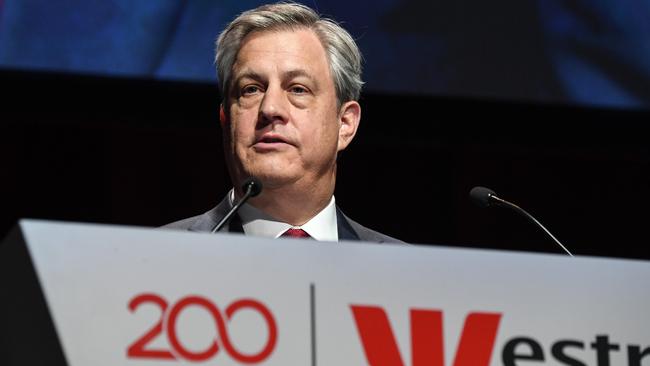APRA’s $1.5bn hit on bank culture
Westpac has insisted its problems with corporate culture are not as bad as cross-town rival Commonwealth Bank.

Westpac has insisted its problems with corporate culture are not as bad as cross-town rival Commonwealth Bank, despite the financial regulator yesterday criticising it over gaps in its risk settings and forcing it to hold an extra $500 million in capital.
The comments came as the Australian Prudential Regulation Authority confirmed it would force three of the big four, including Westpac, to each carry an extra $500 million on their balance sheet as it panned them for substandard risk governance.
The penalty caps off a horror run for the sector following the Hayne royal commission forcing the major banks to re-evaluate how they treat customers, from lending to the provision of financial advice. Collectively the major banks and wealth manager AMP have paid out billions in compensation and compliance related to wrongdoing.
But in its self-assessment on culture, governance and accountability, submitted to APRA last year and released by Westpac yesterday, the lender said any problems weren’t as bad as the behaviour seen at CBA in recent years.
“The prominent behavioural characteristics at CBA identified by the Prudential Inquiry, particularly a sense of chronic ease, complacency, and certain governance-related issues, are not similarly prominent at Westpac,” the bank said.
The financial regulator imposed the additional capital requirements on ANZ, National Australia Bank and Westpac after it reviewed their culture, governance and accountability self-assessments and found they had “fallen short in a number of areas”.
The banks would have to hold the extra capital from September 30 until they strengthened their risk management and resolved any weaknesses, APRA said.
The higher capital could force the banks to trim their dividend, or at the margin reduce the pace of lending growth.
Even so, the market took the news in its stride, with Westpac closing up 0.39 per cent at $27.98, NAB finishing up 0.97 per cent at $27.12 and ANZ closing down 0.76 per cent at 27.32. CBA finished the session flat at $81.24.
The financial regulator has already forced CBA to hold an additional $1 billion in regulatory capital, after last year’s damning APRA-led review of the nation’s largest lender found a “widespread sense of complacency” and a “reactive stance”. Following that review APRA ordered the other banks to conduct their own assessments of their risk and culture.
“Although the self-assessments raised no concerns about financial soundness, they confirmed that many of the issues identified in the Inquiry were not unique to CBA,” APRA chairman Wayne Byres said yesterday.
“Australia’s major banks are well-capitalised and financially sound, but improvements in the management of non-financial risks are needed.
“The major banks play a vital role in the stability of the entire financial system, and APRA expects them to hold themselves to the highest standards of risk governance. Their self-assessments reveal that they have fallen short in a number of areas, and APRA is therefore raising their regulatory capital requirements until weaknesses have been fully remediated,” Mr Byres said.
Shaw and Partners banking analyst Brett Le Mesurier said the extra capital requirement was a warning to the banks.
“It’s enough to say ‘pay attention to this’ without it being a severe financial penalty. But it’s definitely a warning for them to fix (their risk and culture up),” he said.
While distancing itself from the behaviour of the nation’s largest lender, Westpac admitted that the banking industry had lost the trust of the community.
“The industry has no one to blame but itself. In the past decade it provided the country with what seemed an endless supply of customer failings, many giving rise to genuine questions about bank and employee integrity,” the bank said.
But at the same time, it said its governance, accountability and culture settings, “in their totality”, showed sound management of its non-financial risks.
Instead, it identified that its management of non-financial risks was “less mature” than its management of financial risks and that this was the likely cause of its issues.
The bank did however find that its conduct echoed some of APRA’s less serious findings in its inquiry into CBA.
“These include a lack of clarity on accountabilities and consequences, and challenges in rapidly identifying, prioritising, escalating and remediating issues,” Westpac said.
Westpac is the second of the three lenders to release its self-assessment. NAB’s report, released late last year, found that executives did not apply “sufficient intensity and urgency” to longstanding issues and failed to move quickly enough to address weaknesses once recognised. ANZ has yet to release its own self-assessment.
“We have a longstanding approach that all such documents are for the regulator to determine when and how they are made public,” an ANZ spokesman said last night.
In an update to shareholders, Westpac CEO Brian Hartzer agreed the bank needed to improve its risk management and said it was working through the issues raised.
“Our board and senior executives are committed to addressing the shortfalls identified in the report and will continue to provide regular updates on our progress,” he said yesterday.
The bank had so far implemented 20 per cent of the recommendations that came out of its self-assessment, he said.
Commenting on the $500m capital add-on imposed on NAB, CEO and chairman-elect Philip Chronican said the bank was working through its own program of reform and had already made “material progress”.
“NAB’s self-assessment on culture, accountability and governance sets out a clear program of reform,” Mr Chronican said.





To join the conversation, please log in. Don't have an account? Register
Join the conversation, you are commenting as Logout